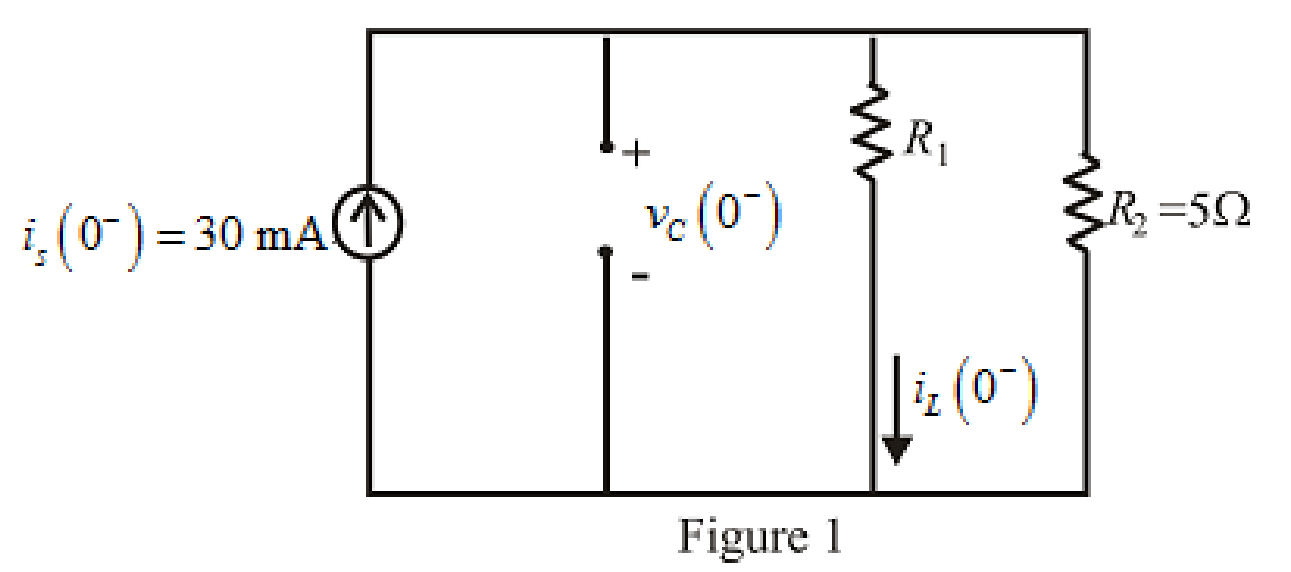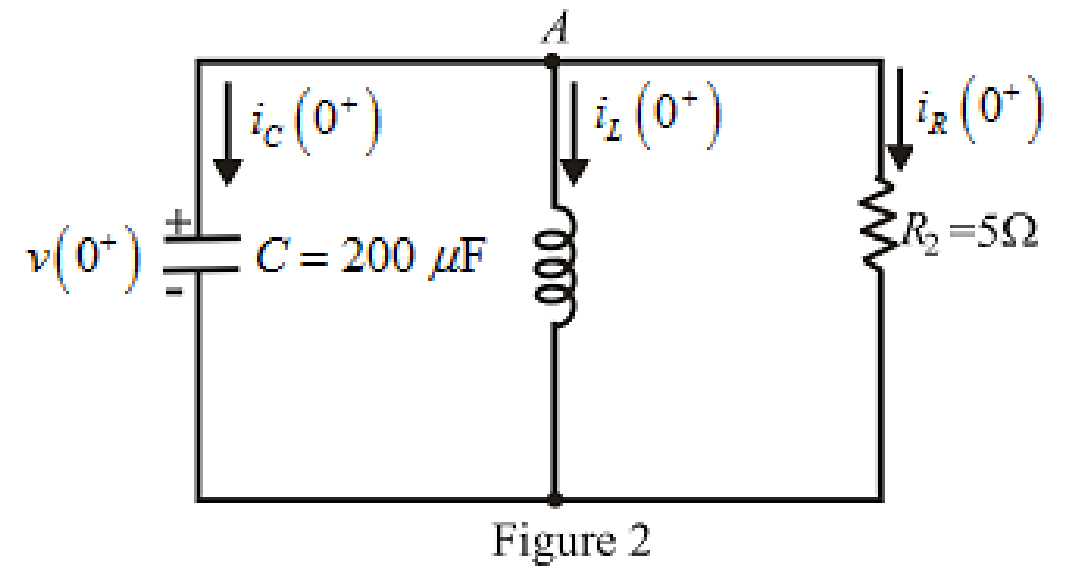
For the circuit of Fig. 9.45, is(t) = 30u(−t) mA. (a) Select R1 so that v(0+) = 6 V. (b) Compute v(2 ms). (c) Determine the settling time of the capacitor voltage. (d) Is the inductor current settling time the same as your answer to part (c)?

FIGURE 9.45
(a)
Select
Answer to Problem 26E
The resistance
Explanation of Solution
Given Data:
Formula used:
The expression for the exponential damping coefficient or the neper frequency is as follows:
Here,
The expression for the resonant frequency is as follows:
Here,
The expression for a critically damped response of a source free parallel RLC circuit is as follows:
Here,
Calculation:
The unit-step forcing function as a function of time which is zero for all values of its argument less than zero and which is unity for all positive values of its argument.
Here,
So, at
The redrawn circuit diagram is given in Figure 1 at

Refer to the redrawn Figure 1:
The expression for the current through the inductor at
Here,
The expression for the voltage across the capacitor at
Here,
Substitute
The capacitor does not allow sudden change in the voltage, so,
The voltage across the capacitor at
Substitute
Rearrange for
The resistance cannot be negative so, the resistance
Conclusion:
Thus, the resistance
(b)
Compute
Answer to Problem 26E
The value of the voltage
Explanation of Solution
Given data:
The time is
Calculation:
Substitute
The inductor does not allow sudden change in the current.
So,
So the current through inductor at
The redrawn circuit diagram is given in Figure 2 at

Refer to the redrawn Figure 2:
The expression for the current flowing in the
Here,
Substitute
Apply KCL at node
Here,
Substitute
Rearrange for
Substitute
Substitute
Substitute
Substitute
The voltage across the capacitor at
Substitute
Rearrange for
The expression for the current flowing through the
Substitute
Rearrange for
Substitute
The current flowing through the
Substitute
Substitute
Rearrange for
Substitute
Substitute
Conclusion:
Thus, the value of the voltage
(c)
Determine the settling time of the capacitor voltage.
Answer to Problem 26E
The settling time of the capacitor voltage is
Explanation of Solution
Calculation:
The maximum voltage appears across the capacitor at
So, for maximum voltage,
Substitute
Settling time is the time at which the value of the voltage reaches
The expression for the voltage at
Here,
Substitute
Substitute
The value of
Conclusion:
Thus, the settling time of the capacitor voltage is
(d)
Is the inductor current settling time the same as your answer to part (c)?
Answer to Problem 26E
The inductor current settling time is not same as capacitor voltage settling time.
Explanation of Solution
Calculation:
The expression for the current through inductor is as follows:
Here,
Substitute
Simplify further.
The maximum current through the inductor is at
So, for the maximum current,
Substitute
Settling time is the time at which the value of the current reaches
The expression for the current at
Here,
Substitute
Substitute
Rearrange equation (22).
The value of
So the inductor current settling time is
Conclusion:
Thus, the inductor current settling time is not same as capacitor settling time.
Want to see more full solutions like this?
Chapter 9 Solutions
Engineering Circuit Analysis
- A left-sided signal x(t)=-ebt u(-t): A right-sided signal x(t)=e¯at u(t) Find Laplace transform of x(t)=u(t)arrow_forwardFind Laplace transform of x(t) = −e¯btu(−t) + e¯atu(t) Find Laplace transform of x(t) = u(t)arrow_forwardExpert only, don't use artificial intelligence ,or screenshot of an AI solving stepsarrow_forward
- find inverse LT for the following functions 1- [0.2s+1.4] s2+1.96. 2. L-1 5s+1 Ls2-25. 4s+32 3. L- L(s2-16).arrow_forwardQ Figurel shows the creation of the Frequency Reuse Pattern Using the Cluster Size K (A) illustrates how i and j can be used to locate a co-channel cell. Juster Cluster CB Cluster 2 X=7(i=2,j=1)arrow_forwardDon't use ai to answer I will report you answerarrow_forward
- Q2. For the transformer shown in Fig. 1. A. Plot the winding connection for the transformer and justify your answer. (4M) B. If the transformer is adopted in 12 pulse diode rectifier, where two-series connected bridge rectifiers are used to supply a highly inductive load with 100 A. (i) Select a suitable turns ratio for the transformer (ii) Plot the line current of each winding ( secondary + primary) showing the current magnitude at each interval (iii) Use Fourier Page 1 of 3 analysis to obtain the Fourier series of all line currents then calculate the THD of the input current. (8=0° (16M) (Y) = 30° Fig. 1 P. I v Iarrow_forwardQ2. For the transformer shown in Fig.1, A. Find the phase shift between the primary and star-connected secondary. B. If the transformer is adopted in a 12-pulse diode rectifier, where a two-series connected bridge rectifier is connected in series and supplies a highly inductive load (i) Select a suitable turns ratio for the transformer (ii) Plot the line current of each winding (secondary + primary). (iii)Using Fourier analysis to obtain the Fourier series of all line currents, then calculate the THD of the input current. (iv) Draw the output voltage of the first and second rectifiers and give the relation of the total output voltage. N2 B C Fig. 1 N3 aarrow_forwardQ2.A. It is planned to use the transformer shown in Fig. 1, a 12-pulse rectifier. Each secondary is connected to three phase controlled bridge rectifier. The two rectifiers are connected in series to supply a highly inductive load. 1. Based on the phasor relationship between different windings. If suitable turns ratio is selected, is it possible to use this transformer to produce 12 pulse output voltage? Show the reason behind your answer. 2. Assuming this arrangement is possible to be used in 12-pulse rectifier, draw the output voltage of the 1st and 2nd rectifier and give the relation of the total output voltage. 3. Use the Fourier analysis to show the harmonics in all line currents of the transformer. A B in C Fig. 1 b la a 2 b.arrow_forward
 Introductory Circuit Analysis (13th Edition)Electrical EngineeringISBN:9780133923605Author:Robert L. BoylestadPublisher:PEARSON
Introductory Circuit Analysis (13th Edition)Electrical EngineeringISBN:9780133923605Author:Robert L. BoylestadPublisher:PEARSON Delmar's Standard Textbook Of ElectricityElectrical EngineeringISBN:9781337900348Author:Stephen L. HermanPublisher:Cengage Learning
Delmar's Standard Textbook Of ElectricityElectrical EngineeringISBN:9781337900348Author:Stephen L. HermanPublisher:Cengage Learning Programmable Logic ControllersElectrical EngineeringISBN:9780073373843Author:Frank D. PetruzellaPublisher:McGraw-Hill Education
Programmable Logic ControllersElectrical EngineeringISBN:9780073373843Author:Frank D. PetruzellaPublisher:McGraw-Hill Education Fundamentals of Electric CircuitsElectrical EngineeringISBN:9780078028229Author:Charles K Alexander, Matthew SadikuPublisher:McGraw-Hill Education
Fundamentals of Electric CircuitsElectrical EngineeringISBN:9780078028229Author:Charles K Alexander, Matthew SadikuPublisher:McGraw-Hill Education Electric Circuits. (11th Edition)Electrical EngineeringISBN:9780134746968Author:James W. Nilsson, Susan RiedelPublisher:PEARSON
Electric Circuits. (11th Edition)Electrical EngineeringISBN:9780134746968Author:James W. Nilsson, Susan RiedelPublisher:PEARSON Engineering ElectromagneticsElectrical EngineeringISBN:9780078028151Author:Hayt, William H. (william Hart), Jr, BUCK, John A.Publisher:Mcgraw-hill Education,
Engineering ElectromagneticsElectrical EngineeringISBN:9780078028151Author:Hayt, William H. (william Hart), Jr, BUCK, John A.Publisher:Mcgraw-hill Education,





